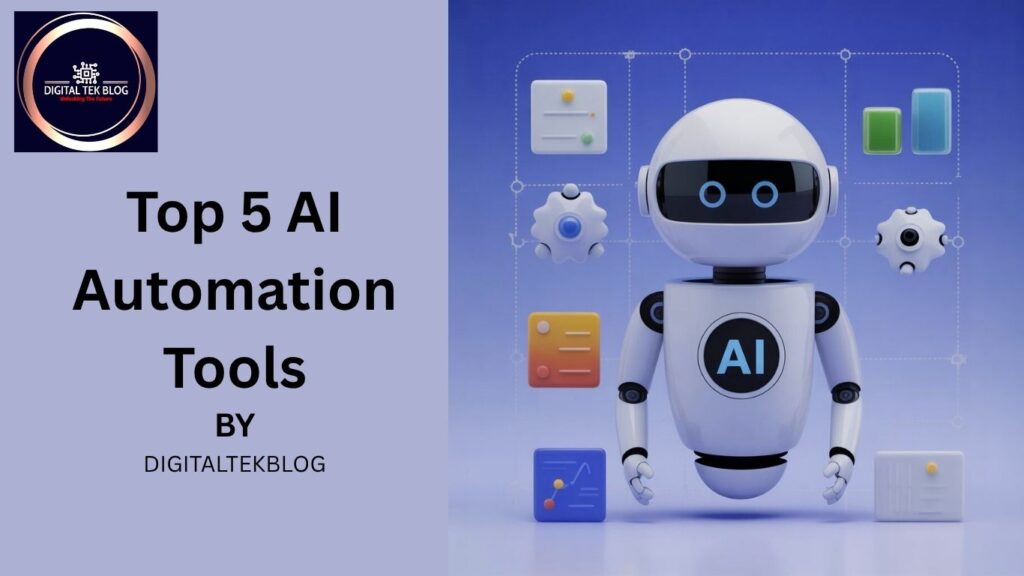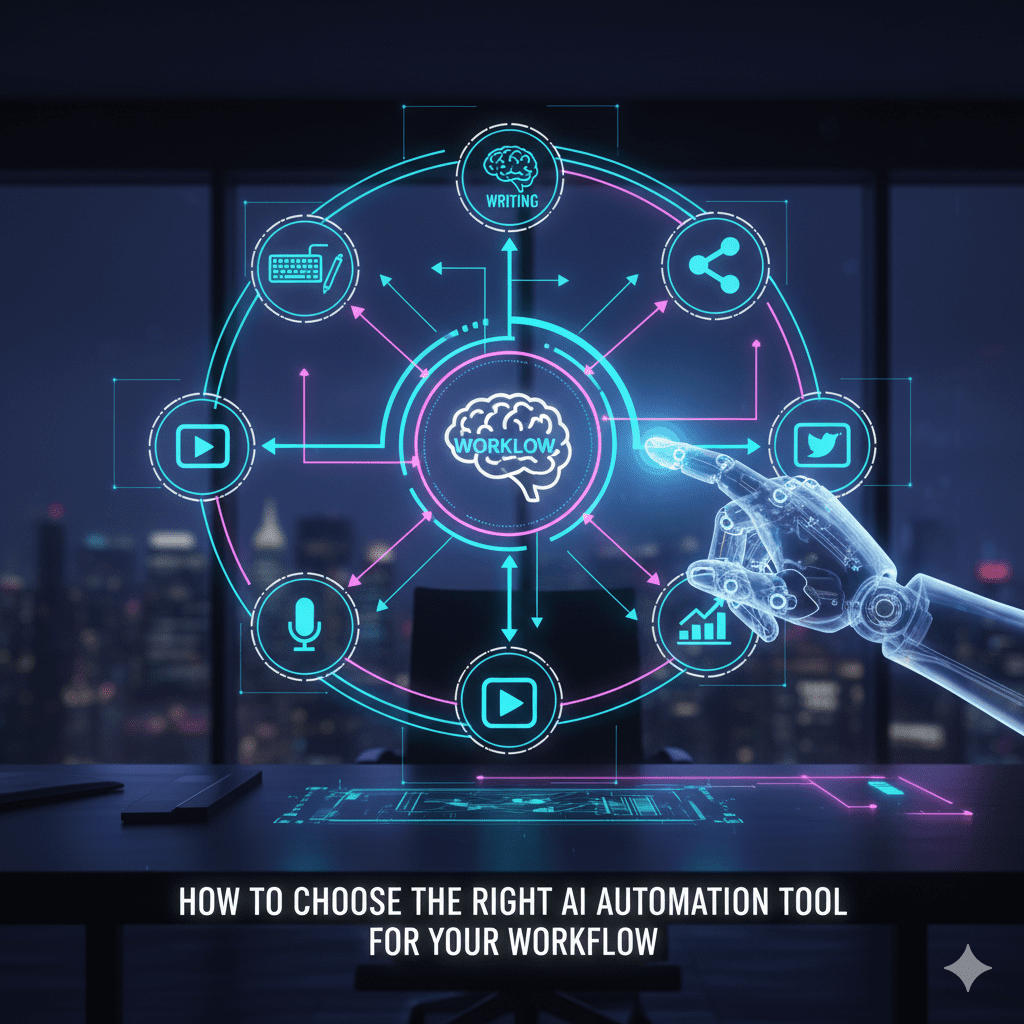Introduction: AI Automation Tools
Content creation today isn’t just about writing or posting—it’s about juggling multiple responsibilities: research, drafting, editing, optimizing for SEO, designing visuals, scheduling, and tracking performance. Many creators feel overwhelmed and struggle to maintain consistency and quality.
The rise of AI automation tools is transforming how creators work. With these tools, you can automate repetitive tasks, streamline your workflow, improve quality, and free up more time for creative thinking.
In this comprehensive guide, we’ll explore the best AI automation tools for content creators in 2025, dive deep into key features to consider, provide actionable tips to maximize productivity, reveal common mistakes to avoid, and look at the future of AI-powered content creation.
Why Content Creators Need AI Automation Tools in 2025
AI automation is no longer a luxury—it’s a necessity. Content creators face several pain points today:
- Time-consuming research: Finding trending topics and credible sources can take hours.
- Repetitive editing tasks: Proofreading, formatting, and SEO optimization require constant attention.
- Content saturation: Standing out requires creativity and data-driven insights.
AI automation tools solve these challenges by:
- Idea generation: AI can suggest content topics based on trends and audience interest.
- Workflow automation: Schedule posts, auto-generate captions, and distribute content across platforms.
- Quality enhancement: Tools analyze readability, grammar, tone, and engagement metrics.
- Performance insights: AI analytics track engagement, conversions, and audience behavior.
Result: Creators can produce more high-quality content in less time without compromising originality.
Key Features to Look for in AI Automation Tools
When evaluating AI automation tools, consider these features carefully:
1. Multi-format Content Generation
Modern content creation isn’t limited to text. Look for AI that can generate:
- Articles and blog posts
- Social media captions
- Infographics and images
- Short-form and long-form video
2. Integration Capabilities
Seamless integration with tools like WordPress, Canva, Mailchimp, HubSpot, and social media platforms ensures smoother workflow and avoids manual transfers.
3. Ease of Use
Tools should have an intuitive interface with minimal setup time. Drag-and-drop editors, pre-built templates, and guided workflows reduce the learning curve.
4. Analytics and Insights
Top AI tools provide actionable insights:
- Engagement metrics
- Click-through rates (CTR)
- Content performance trends
- Suggestions to improve readability and reach
5. Scalability and Pricing
- Freelancers or small creators may need affordable entry-level plans.
- Growing teams require enterprise features like team collaboration, API access, and multi-channel support.
Top AI Automation Tools for Content Creators in 2025

Here’s a detailed breakdown of the best AI automation tools that combine efficiency, creativity, and analytics:
1. Jasper AI
- Overview: Leading AI writing assistant.
- Best For: Blog posts, ad copies, email sequences, and social media content.
- Key Features: Multi-language support, AI templates, SEO-focused content.
- Example Use Case: A creator can generate a 1,500-word blog in under 15 minutes with Jasper’s SEO integration.
- Pros: Fast, versatile, and consistent output.
- Cons: Subscription cost may be high for small creators.
2. Canva AI
- Overview: AI-powered graphic design platform.
- Best For: Social media visuals, presentations, thumbnails, and infographics.
- Key Features: Magic Resize, AI-generated layouts, and auto-suggested graphics.
- Example Use Case: Quickly transform blog ideas into shareable visuals for social media campaigns.
- Pros: Intuitive, visually rich templates, free plan available.
- Cons: Limited advanced design capabilities compared to Photoshop or Illustrator.
3. GrammarlyGO
- Overview: Advanced AI writing assistant.
- Best For: Improving text clarity, grammar, tone, and conciseness.
- Key Features: Tone adjustment, plagiarism detection, and sentence rephrasing.
- Example Use Case: Edit a draft blog for tone consistency and readability in minutes.
- Pros: Excellent grammar checks and clarity suggestions.
- Cons: Focused mainly on text; limited multimedia support.
4. Description
- Overview: AI-driven video and audio editor.
- Best For: Podcasters, video creators, and tutorial makers.
- Key Features: Automatic transcription, overdubbing, and AI-generated video captions.
- Example Use Case: Turn a podcast episode into a full video with synced captions and highlights automatically.
- Pros: Saves hours of editing, great for collaborative workflows.
- Cons: Processing large video files can be slow.
5. Lumen5
- Overview: Converts text content into videos quickly.
- Best For: Social media content and video marketing.
- Key Features: AI storyboard, automatic scene creation, royalty-free media library.
- Example Use Case: Transform a 1,200-word blog into a 2-minute promotional video for social media.
- Pros: Quick, easy, visually appealing.
- Cons: Limited customization on free or basic plans.
How to Choose the Right AI Automation Tools for Your Workflow

- Identify Bottlenecks: Pinpoint which tasks consume the most time (writing, editing, visuals, distribution).
- Assess Your Budget: Compare pricing vs. features and scalability.
- Test Before Committing: Use free trials to understand usability and ROI.
- Consider Collaboration: For teams, ensure the tool supports multiple users and real-time editing.
Tips to Maximize Productivity with AI Tools
- Combine Tools for Full Workflow: Use one tool for writing, another for visuals, and a third for analytics.
- Leverage Templates and Presets: Save time on recurring tasks.
- Monitor Analytics: Use AI insights to tweak your content strategy continuously.
- Maintain Creative Control: Use AI as a productivity assistant, not a replacement for human creativity.
Common Mistakes Content Creators Make with AI Automation
- Over-Automation: Completely relying on AI leads to generic content that lacks personal touch.
- Ignoring Metrics: Skipping analytics prevents optimization and growth.
- Tool Misalignment: Using a tool that doesn’t fit your workflow can cause inefficiency.
- Neglecting Updates: Not keeping up with new AI features may leave you behind competitors.
The Future of AI Automation Tools for Content Creation
- Predictive AI: Suggests content based on audience engagement trends.
- Voice and Conversational AI: Interactive content formats like chatbots and audio-driven content.
- End-to-End Automation: Tools that combine writing, visual design, video editing, and analytics into a single platform.
- AI for Personalization: Content tailored dynamically to individual audience preferences, boosting engagement and loyalty.
Creators who adapt to these trends early will gain a significant competitive edge in 2025 and beyond.
Frequently Asked Questions (FAQ)
Q1: What is an AI automation tool for content creators?
A1: It’s software that uses AI to automate repetitive tasks in content creation, such as writing, editing, designing, publishing, and tracking performance.
Q2: Can AI tools replace human creativity?
A2: No. AI assists in efficiency and provides suggestions, but human insight is essential for originality, storytelling, and emotional resonance.
Q3: Are AI automation tools suitable for small creators or startups?
A3: Yes. Many tools offer scalable pricing, making them accessible for individuals, freelancers, and small teams.
Q4: How can AI tools help improve content quality?
A4: By providing suggestions for grammar, readability, tone, design, and engagement optimization, AI helps creators refine their content faster and more effectively.
Conclusion
AI automation tools are transforming the content creation landscape in 2025. By carefully choosing tools that fit your workflow, understanding their features, and using them strategically, you can produce higher-quality content faster, streamline your workflow, and focus on what truly matters—creativity and audience connection.
Start experimenting with the tools outlined here, combine them for maximum efficiency, and embrace AI as your productivity partner rather than a replacement.

